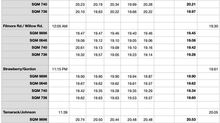Look Under Moon
- Chuck Bueter
- May 22, 2015
- 3 min read
The timing of this double-header in the sky couldn't be better. On Friday, May 22, as the 150th anniversary of South Bend's First Midnight approaches, a pair of Iridium flares will suddenly appear low in the western sky and almost slice through the thin crescent moon and Venus! Even if you don't know what that means, if you're in South Bend on Friday night, after the River Lights ceremony and after the fireworks, at 11:21 p.m. and again at 11:30 p.m. look under the moon and observe. Gotta love serendipity.

What is it?

You're actually witnessing sunlight reflecting off the polished antenna of an Iridium communication satellite. The satellite anntena is like a door-sized mirror, and at the predicted moment the surface reflects a swatch of sunlight across southern Michigan and northern Indiana. As the time approaches you may be able to see the satellite (one of dozens of Iridium satellites in orbit) as a faint point of light growing in brightness and moving from left of the moon to its right. When the satellite appears nearly under the moon it peaks in brightness--the flare--and then diminishes again. The satellite continues northward, gliding just over Venus.
On Friday night, however, you'll see the bonus of two distinct satellites flaring back-to-back. The first one at 23:21:36 (yes, the peak is predicted to the second) is the satellite Iridium 62, with the sun bouncing off its forward antenna. Its peak magnitude will be mag= -3.4. The second flare at 23:30:44 is from the satellite Iridium 14, with its magnitude being a fainter but respectable mag= -1.1. For comparison, the planet Jupiter is bright at mag= -2, and Venus is dazzling at mag= -4.2.
On Saturday, May 23, though the moon has moved east slightly the scene repeats (see table below), only this time with the satellites Iridium 65 at 23:15:40 and Iridium 66 at 23:24:53 at mag= -5, which is brighter than Venus. The flare of Iridium 14 at 10:29 p.m. on Sunday, May 24, nearly touches Jupiter. The magnitude, or brightness, will vary depending on where you are relative to the path of the flare's center.
Parlor Game
Feel like tricking your friends? If you know about an upcoming Iridium flare, which are regularly predicted at Heavens-Above, play it up. When with a small group of students I like to tell them that individually they can achieve much, but collectively as a team they have the power to conjure up an apparition in the sky. Let's prove it. I suggest the general area to look, then as the time of the flare approaches I encourage them all to hum...louder...louder. Flare!
Astronomy at SB150
For the SB150 celebration, members of the local amateur astronomy community will be set up on the Jefferson St. bridge on Saturday evening and night. Just look for the telescopes and observe some of the May celestial highlights as we commemorate South Bend's First Midnight (related blog posts here) We invite you to ask about some of the astronomy programs and events occurring in our community, which you'll see described on a big sandwich board:
Also in the Sky
Here's a larger map of the night sky to be held overhead--west is the right edge with the moon and planets, east is the left edge, north is the top, and south is the bottom. While you're stargazing, look for Eltanin, the brightest (but still fairly faint at mag= +2.2) star in Draco the Dragon. Eltanin is South Bend's birthday star at approximately 150 light years away. Below is a zoomed image of the western horizon.


Additional Iridium flare predicitons, courtesy of Chris Peat at Heavens-Above.com, for South Bend during its birthday weekend celebration are shown below.









































